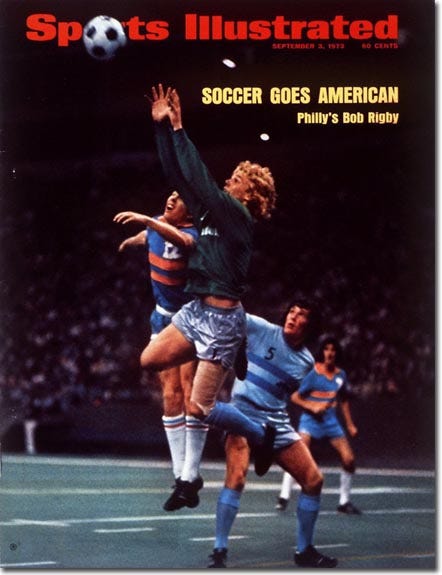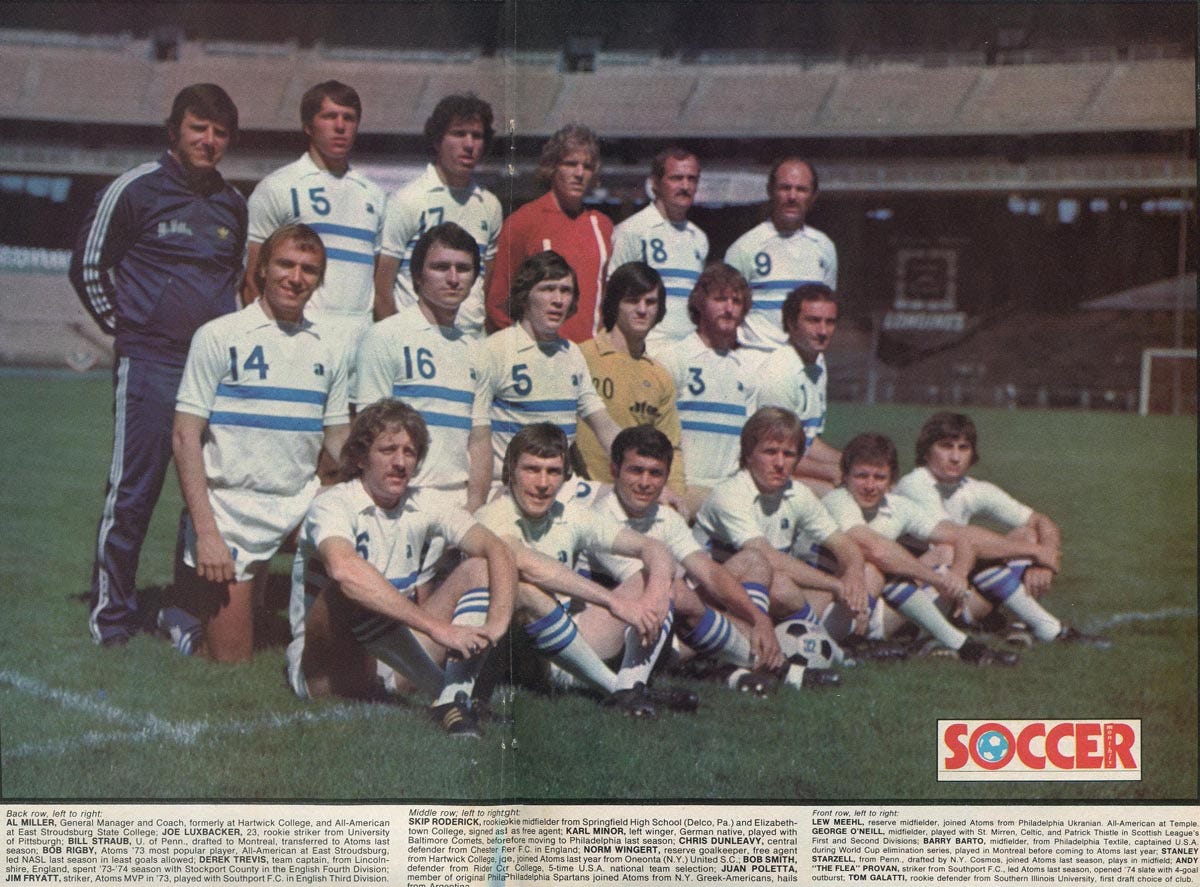Communists, Caviar, and a Conception (Part 1/2)
Or, How the NASL's Philadelphia Atoms Brought the Russians to Town and Accidentally Spawned the MISL
“It should be like Ali-Frazier in a phone booth…”
– Feb. 10, 1974, Bill Lyon, Philadelphia Inquirer sports columnist, on the Philadelphia Atoms versus Moscow Red Army indoor soccer match.
Every superhero has an origin story. The same goes for sports leagues. For the Major Indoor Soccer League, it all started with a fella checking out a rug.
As the owner of the National Lacrosse League’s Philadelphia Wings, Ed Tepper wanted to see if the new AstroTurf playing surface at the Philadelphia Spectrum arena could be adapted for his team’s use. But his curiosity quickly turned from the field itself to what was happening on top of it.
After a couple of hours of watching outdoor soccer players kick a ball around the turf, on a hockey-sized field with sideboards, under a roof, with a new set of rules, witnessed by a screaming crowd of 11,784 fans (who didn’t even know what exactly they’d just became a fan of), he found himself, postgame, standing in front of North American Soccer League coach Al Miller in the dressing room of his Philadelphia Atoms.
“When is this league going to start?” said Tepper.
“I don’t think it is. This is just an exhibition game,” Miller replied.
Tepper was incredulous.
“Oh my God, you have a gold mine on your hands. Why don’t you start a league???” said Tepper.
“Why don’t YOU start it?” Miller jokingly replied.
So he did.
In early 1974, the North American Soccer League (NASL) had yet to hit its peak Pelé-George Best-Johan Cruyff-Giorgio Chinaglia years. But it was a league, and a sport, on the rise in America. Attendance had risen each season since 1969 and the future seemed bright. The upcoming 1974 campaign would see an expansion from nine to 15 teams and a TV contract with CBS.
The previous year, coach Miller and his Philadelphia Atoms became the first American expansion team of any major sport to win a championship in their first season. Miller started six Americans, including Sports Illustrated coverboy Bob Rigby. Though foreign players would thoroughly dominate professional soccer in America, outdoor and indoor, for most of the next 40 years, it was a promising start for American involvement in professional soccer: the league named Miller “Coach of the Year” and Kyle Rote, Jr. “Rookie of the Year.”
But Miller and the rest of the league faced a significant challenge: the teams only played for just over four months a year. The low salaries made it a part-time profession for most of the players. After winning the championship, the players came to Miller, desperately wondering what they should do now.
“The trouble is, we’re part-time players. If we got a chance to play nine months a year, we could compete on a world level. We’re on the fringe right now,” goalkeeper Bob Rigby told the Philadelphia Daily News’ Phil Jasner.
Would they have to hit the unemployment line until the next season began? Atoms owner Tom McCloskey, a legendary construction magnate responsible for much of the Philadelphia skyline, had little wiggle room in his budget.
“We tried to convince him to keep staff and even get more staff to capitalize on ticket sales and marketing after winning a championship,” said Miller.
But since revenue only flowed for four months, McCloskey didn’t have much of a choice but to temporarily lay off the players and most of the staff in the offseason. He did keep Miller on, and even made him general manager of the team. But the only way the players could make more money would be to make more games happen.
If you’ve heard the term “butterfly effect” it’s probably because you’ve a) seen the Dr. Ian Malcolm (aka Jeff Goldblum) scene in Jurassic Park, OR b) seen the 2004 Ashton Kutcher film of the same name. In plain English, it is defined as the sensitive dependence on initial conditions in which a small change in one state of a deterministic nonlinear system can result in large differences in a later state. Sorry, that wasn’t plain English. In actual plain English, it’s when a small occurrence results in a big change in an event happening at a later date.
The term originates in the meteorological community: a butterfly flaps its wings, and a series of cascading effects result in a weather pattern that causes a hurricane to happen in Florida instead of Texas.
In 1973, the butterfly spoke Portuguese.
“I get this call from an impresario in Portugal. He says, ‘I’ve got a way to make a lot of money for your team.’ Of course, I was all ears,” Al Miller said.
The promoter had the rights to the Moscow Red Army soccer team and he wanted to bring them to America.
“Every American wants to see a real-live Russian,” he told Miller.
Miller told him that a preseason game would work just fine.
“He said, ‘No, no, they want to do it during their winter break.’ I said, ‘Well, what time of year are you talking about?’ He said, ‘February.’ I go, ‘Are you kidding me? We might not get 50 spectators to an outdoor game in Philadelphia in February. It just ain’t gonna happen,’” Miller said.
But for the next three weeks the impresario kept bugging Miller. Surely, they could put something together, he implored. But Miller couldn’t imagine a soccer game in the furious Philly winter. Then he remembered that the NASL had meddled around with some indoor rules and even staged a tournament back in 1971. The league office agreed to provide turf and goals. So, the next time the impresario called, Miller gave him the good news: “We’re on.”
The Soviet Red Army team agreed to play three matches in North America: an opener in Toronto, then Philadelphia and finishing up in St. Louis. The NASL put together an all-star squad for the Toronto match, coached by Miller. The game would be taped for a later showing on ABC’s Wide World of Sports.
Miller assembled his team of all-stars at Maple Leaf Gardens on February 7, 1974. The skill of the Soviet players was on full display. A crowd of either 8,000 or 12,300, depending on whom you believe, watched America’s Cold War enemy score eight goals on their way to a victory. The all-star squad managed four goals in response, from players on three different teams: New York (Jorge Siega x2), Philadelphia (Bobby Smith) and Toronto (Gene Strenicer).
The Soviet team had a built-in advantage: they spent six months training to play indoors and then applied that training in a Soviet soccer tournament. The all-star team had almost no prep time. But Miller had been able to cobble together some practice time for his Atoms.
“We got a couple of days in a makeshift hockey arena in Philadelphia; not good enough, but at least got a couple of days,” Miller said.
The Philadelphia match had the feel of a main event, with Toronto serving as the undercard. The Philadelphia media certainly did their part to beat the drum; in particular, Bill Lyon of the Philadelphia Inquirer:
“…these Russians are called the Red Army of Moscow, which sounds like they oughta be on loan from the Cossack cavalry, pillaging and looting and generally overrunning villages in Eastern Europe,” Lyon wrote.
(TO BE CONTINUED NEXT WEEK)
Coming Next Week: Part 2/2 of Communists, Caviar, and a Conception…
Selected Bibliography
Hanlon, Tim, host. “EPISODE #103: MISL Indoor Soccer's Origin Story – With Co-Founder Ed Tepper.” Good Seats Still Available (podcast). March 9, 2019. https://goodseatsstillavailable.com/listen/2019/3/9/episode-103-the-major-indoor-soccer-leagues-origin-story-with-co-founder-ed-tepper
Hanlon, Tim, host. “EPISODE #71: National Soccer Hall Of Fame Coach Al Miller - Part Two.” Good Seats Still Available (podcast). July 21, 2018. https://goodseatsstillavailable.com/listen/2018/7/21/episode-70-national-soccer-hall-of-fame-coach-al-miller-part-two
Holroyd, Steve. “Russians, Atoms, and the birth of indoor soccer.” The Philly Soccer Page. February 11, 2019.
Jasner, Phil. “Atoms Shot in Russian Roulette.” Philadelphia Daily News. February 12, 1974.
Lyon, Bill. “If Russians are Coming, Do We Defuse Atom Bomb?” The Philadelphia Inquirer. February 10, 1974.
Lyon, Bill. “Atoms Fall to Red Army Blitz.” The Philadelphia Inquirer. February 12, 1974.
Lyon, Bill. “No Bomb, the Atoms Aim for a 2nd Blast.” The Philadelphia Inquirer March 18, 1974.
Miller, Al. Interview by Tim O’Bryhim. November 10, 2023.
Staff. “Red Army Too Much for NASL Stars.” Philadelphia Daily News. February 8, 1974.
Staff. “Kelly Sends Red Letter.” Philadelphia Daily News. February 12, 1974.
Tepper, Ed. Interview by Tim O’Bryhim. November 10, 2023.





good stuff!
reading bibliography, very cool that you got to interview Ed Tepper.